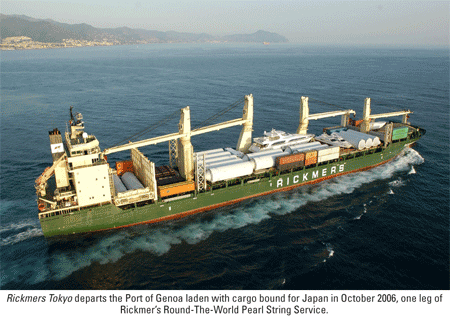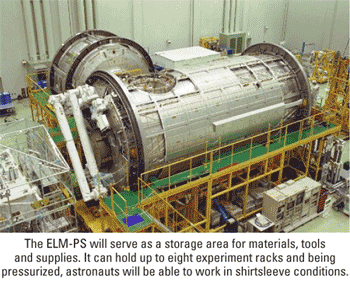 By Karen E. Thuermer, AJOT
By Karen E. Thuermer, AJOTIn October 2006, a photograph taken of Rickmers Tokyo as she left Italy bound for Asia showed the range of cargo carried on a typical round-the-world voyage for Hamburg-based Rickmers-Linie. As she departed, every square foot of deck space was utilized, as was the entire underdeck capacity.
Aboard the vessel were a number of tanks for a Thai brewery project, four below deck and the remainder above deck. Also on deck was a collection of expensive yachts. The image may have been striking for the untrained eye, but for Rickmers it was very much an everyday event.
Extraordinary cargoIn contrast, a sailing took place a few months later with cargo that truly warranted the term ‘extraordinary’. That sailing involved the Rickmers New Orleans, one of nine identical ships maintaining Rickmers-Linie’s bi-weekly Round-The-World Pearl String Service. Aboard the vessel was the Experiment Logistics Module - Pressurised Section (ELM-PS) of the Japanese Experiment Module Kibo (Hope) en route from Japan to the United States.
Kibo is part of Japan’s contribution to the International Space Station (ISS) project, and is probably one of the most valuable items of cargo ever carried on a scheduled liner vessel.
The module, 11 meters long and four meters in diameter, was loaded in Yokohama on February 7 and discharged in Port Canaveral, FL, close to NASA’s Kennedy Space Center, on March 11. Loading was undertaken under the close scrutiny of executives from the Japan Aerospace Exploration Agency (JAXA) and NASA, joined by Bertram R. C. Rickmers, chairman of the Rickmers Group, and Jan B. Steffens, managing director of Rickmers-Linie.
Gerhard Janssen, Rickmers-Linie’s general manager, Marketing and Sales, describes the handling of Kibo as akin to handling the finest piece of porcelain.
“This was the most precious cargo ever carried on a Rickmers’ vessel,” he recalls.
Rickmers was completely aware of the need not to hold up the ISS program, yet it could not risk damaging the module by rushing any aspect of the process from the planning to the actual loading and discharging operations.
“We were only too aware that any damage to the complex and delicate scientific instrumentation could hold up the ISS program itself, to say nothing of being immensely costly,” he says.
The
Rickmers New Orleans made a pinpoint arrival on schedule at Port Canaveral, which safeguarded the timetable of the Japanese ISS participation.

“We had no hesitation in having senior executives from NASA and JAXA oversee the loading in Yokohama as we realized the true significance of the shipment,” he adds.
In planning the transportation of this cargo, Rickmers utilized RICOSYS, said to be the world’s first 3D Cargo Management System. RICOSYS (Rickmers Cargo Operations Simulation System) makes possible the simulation of the handling, securing and lashing of cargo in advance at the shipping company’s Hamburg headquarters, resulting in the seamless preparation of a loading operation.
RICOSYS has two principal elements – RICSIM, which covers single items of cargo, and RICSTOW, which covers the loading arrangements of an entire vessel. RICSIM enables the user to visualize the loading of a specific piece of cargo that may be very large, very heavy and/or relatively fragile. It calculates how best to arrange the stowage and how the piece in question will be behave when subjected to forces arising during sea transport. RICSTOW, the stowage component, visualizes and measures how and in which location the item can be loaded onboard the vessel.
Planning the movement of a heavy or out-of-gauge piece of cargo always requires considerable skill and experien

 “We had no hesitation in having senior executives from NASA and JAXA oversee the loading in Yokohama as we realized the true significance of the shipment,” he adds.
In planning the transportation of this cargo, Rickmers utilized RICOSYS, said to be the world’s first 3D Cargo Management System. RICOSYS (Rickmers Cargo Operations Simulation System) makes possible the simulation of the handling, securing and lashing of cargo in advance at the shipping company’s Hamburg headquarters, resulting in the seamless preparation of a loading operation.
RICOSYS has two principal elements – RICSIM, which covers single items of cargo, and RICSTOW, which covers the loading arrangements of an entire vessel. RICSIM enables the user to visualize the loading of a specific piece of cargo that may be very large, very heavy and/or relatively fragile. It calculates how best to arrange the stowage and how the piece in question will be behave when subjected to forces arising during sea transport. RICSTOW, the stowage component, visualizes and measures how and in which location the item can be loaded onboard the vessel.
Planning the movement of a heavy or out-of-gauge piece of cargo always requires considerable skill and experien
“We had no hesitation in having senior executives from NASA and JAXA oversee the loading in Yokohama as we realized the true significance of the shipment,” he adds.
In planning the transportation of this cargo, Rickmers utilized RICOSYS, said to be the world’s first 3D Cargo Management System. RICOSYS (Rickmers Cargo Operations Simulation System) makes possible the simulation of the handling, securing and lashing of cargo in advance at the shipping company’s Hamburg headquarters, resulting in the seamless preparation of a loading operation.
RICOSYS has two principal elements – RICSIM, which covers single items of cargo, and RICSTOW, which covers the loading arrangements of an entire vessel. RICSIM enables the user to visualize the loading of a specific piece of cargo that may be very large, very heavy and/or relatively fragile. It calculates how best to arrange the stowage and how the piece in question will be behave when subjected to forces arising during sea transport. RICSTOW, the stowage component, visualizes and measures how and in which location the item can be loaded onboard the vessel.
Planning the movement of a heavy or out-of-gauge piece of cargo always requires considerable skill and experien




